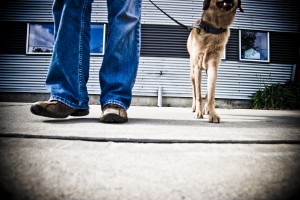
It’s one of the most natural things in the world for us human beings, walking side by side. Unfortunately it’s not at all natural for our dogs. Rarely do they walk that way on their own. When they do, it’s usually only momentarily. That’s what makes teaching loose leash walking so troublesome for so many folks.
Add to that, when our dogs pull we often follow. Dogs learn very early on that putting tension on the leash is just what they need to do to get where they are going. We don’t set any limits and as a result we actually reward our dogs for pulling.
What we really want to do is reward our dogs for walking next to us. I like to start off-leash (yes off-leash) in a safe enclosed area, like a fenced in back yard. Start by walking around the yard casually at your own pace; don’t say anything to the dog. As soon as your dog sidles up beside you simply say “yes” in a cheerful voice and offer him a special bit of food (cheese or boiled chicken is always nice). Then, continue walking on silently. When he comes up alongside you again, say “yes” again and deliver another treat. Before long, you’ll notice that your dog is walking with you with that expectant doggie grin of his. Keep saying “yes” and treating him until you can’t get rid of him.
All that’s left now is putting the leash on, right? Well, that’s almost right. Your dog will notice that things are different out in the wide world, and if he has a history of pulling he’s likely to fall right back into old habits. Here’s what you need to remember. If your dog pulls, stop. No one makes any forward progress when the leash is taught. Gently call your dog “this way” and begin walking the opposite direction with him. Because you’ve changed direction you’ll find that for a moment he’s right beside you where you want him. Say that magic word, “yes” and give him his special treat. Now you’re playing the same training game you were playing in the fenced in yard. The only difference is, you’re out front and the leash is on.
Let’s break this down, because your training really does need to be specific to work quickly. Dog pulls: stop. Change directions. Dog beside you: “yes” and treat. You may “yes” and treat multiple times so long as the dog is walking nicely beside you. For the time being, all of your walks should be this kind of training walk.
Now for the ultimate reward. What your dog really wants to do is sniff and explore. So after a nice spell of walking by your side, smile at your dog and say “yes, go sniff.” Then gleefully let him guide you around a bit for some doggie nose work. It’s okay to let him pull for a short while in this context. We call it a life reward. The dog actually gets what he wants by giving you the behavior you want (walking nicely). It’s powerful reinforcement, with a proven track record. It also happens to be the most natural thing in the world for your dog.
Houston Dog Trainer Michael Baugh, CPDT-KSA, CDBC specializes in behavior related to fearful and aggressive dogs.
